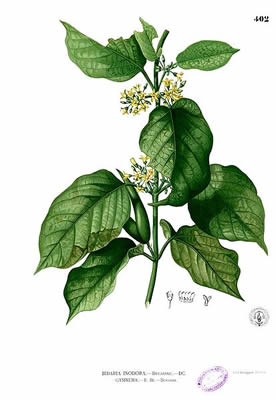Gurmar Gymnema sylvestre
- Common Names
- Gurmar
- Botanical Name
- Gymnema sylvestre
- Family
- ASCLEPIADACEAE
Medicinal Uses & Benefits of Gurmar
![]() How to Use|
Side Effects |
Plant & Garden|
How to Use|
Side Effects |
Plant & Garden|
- Medicinal Uses: * Ayurvedic
* Diabetes
* Diet/weight Loss
- Properties: * Appetite Depressant * Astringent * Refrigerant
- Parts Used: leaf
- Constituents: gymnemic acid, parabin, glucose, and carbohydrates
How to Use: Gurmar
Gurmar (Gymnema sylvestre) has a long history of use in Ayurvedic medicine for the treatment of diabetes, upper respiratory infections, and fevers. The main point of interest in the west is gurmar leaf's effects on insulin levels and blood sugar given the rising epidemic of adult onset type 2 diabetes. Gurmar acts to normalize blood sugar levels only lowering glucose in those who are hyperglycemic. This herb also has a positive effect on triglycerides and cholesterol levels as well. Gurmar is of interest to dieters as well. Taken over a long period of time it has been shown to reduce the sugar cravings that can hijack your sensible eating plans. 1
Preparation Methods & Dosage :Mostly used in capsules do to extremely bitter taste. A traditional dose would be in the range of 6-12 grams of powder leaf. Use in tea form does enable the sugar numbing capability.
Ayurvedic Medicine
 Gurmar has both pungent and astringent tastes, with a net heating effect
Gurmar has both pungent and astringent tastes, with a net heating effect
Plant Description
- Plant Class: Woody Perennial
- Etymology: From the Hindu gurmar - destroyer of sugar.
- Flowers/Fruit/Seeds:Pale yellow, bell shaped flowers
- Parts used: Leaf
- Leaves: Narrow tipped, elliptic, smooth green leaves
- Distribution: Native to the southern tropical forests of India.
Regional Traditions :Ayurvedic *
History and Traditions & Folklore
Its common name is "sugar destroyer", because chewing the leaves destroys the ability to discriminate the sweetness of foods .Gymnema sylvestre has been used traditionally in India for diabetes for over 2,000 years. It has recently become popular as a diet "sugar blocker", but it in it is unproven.- Khalsa, Karta Purkh Singh, Michael Tierra. "The Way of Ayurvedic Herbs", Lotus, (2008)













